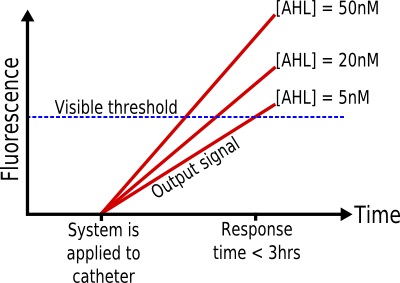Imperial/Infector Detector/Specification
From 2007.igem.org
(Difference between revisions)
(→Specifications in detail) |
(→Infector Detector: Specifications) |
||
| Line 48: | Line 48: | ||
== References == | == References == | ||
| + | |||
| + | # Charlton, TS, et al. A novel and sensitive method for the quantification of N-3-oxoacyl homoserine lactones using gas chromatography–mass spectrometry: application to a model bacterial biofilm. Environmental Microbiology 2 (5), 530–541. October 2000. | ||
Revision as of 22:06, 22 October 2007

Infector Detector: Specifications
The system must be able to detect the presence of biofilms on urinary catheters by detection of AHL, at a minimum concentration of 5nM, and report with a visual signal within 3 hours. It must work within a temperature range of 20°-30°C, be portable and easy to use, have a shelf life of at least seven days, and must not be harmful or infectious.
| Inputs | |
| Outputs | |
| Response Time | |
| Operating Conditions | |
| Health & Safety | |
| Lifespan | |
| Packaging |
Specifications in detail
- Input: AHL 5-50nM
It is known that, in Pseudomonas aeruginosa biofilms, the concentration of AHL is at least 5nM. (1) Therefore, if the system can successfully report the presence of this concentration, it should be able to detect such biofilms.
- Output: Visible fluorescent protein
- Response Time: < 3 hours
- Operating conditions: Temperatures from 20° to 30°C
- Health & safety: Non-living, non-infectious
- Packaging and shelf-life of 7 days
References
- Charlton, TS, et al. A novel and sensitive method for the quantification of N-3-oxoacyl homoserine lactones using gas chromatography–mass spectrometry: application to a model bacterial biofilm. Environmental Microbiology 2 (5), 530–541. October 2000.
